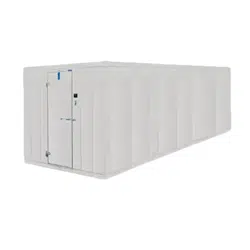Loading ...
Loading ...
Loading ...

6/21 57-02611 / 101628 ©2021, Refrigerated Solutions Group™. All rights reserved. 11
Finish Charging Procedures
A. Preliminary
1. Be sure all service valves are “open”.
2. Loosen the compressor hold-down bolts and remove shipping clips to allow compressor to float freely
on the springs.
3. Check evaporator fan motors after start-up. Medium temperature, air defrosts fans run continuously.
Low temperature fans and coolers provided with electric defrost will be delayed by the fan control.
4. Start the system by “flipping on” the circuit breaker in the unit electric box.
5.
Start charging per (B) or (C) on the following pages.
CAUTION: Never add liquid refrigerant to the suction side of the compressor.
6.
Check operating pressures while charging and on initial pull down to prevent damage if a
problem occurs. If system “floods” back to the compressor, adjust the thermostatic expansion
valve as required for proper operation. There should be at least +30°F superheat entering the
compressor.
7.
Observe compressor amperage draw and compare to compressor nameplate to prevent damage
due to high amperage. The oil sight glass should be between 1/2 and 3/4 full during normal
operation.
B. Remote "M-Series" Condensing Units
1. For models without head pressure control valve: With the system operating, add refrigerant
until the sight glass indicates a full charge, then add one pound for each 2 rated horsepower of
the condensing unit when charging above +75°F. If ambient is below +75°F, add 1/2 to the
above. See A.6 above.
2. For models with head pressure control valve: System should be pressurized with dry
nitrogen to check for leaks.
Once system is confirmed to be leak free a vacuum should be pulled to 500 microns to ensure
no contaminants are in the system.
Once the vacuum is obtained it should be broken on the “high side” of the system with the
refrigerant the system is designed for and roughly 1 to 2 pounds per horsepower as a starting
charge for thermostatic expansion valve (TXV or TEV) systems.
The system can then be started. Gauges will need to be installed on the “high” and “low” side
of the system.
Continue to slowly add refrigerant to the low side of the system. Be sure the direction of the
refrigerant tank is correct. The refrigerant should leave the tank as a liquid but fed slow
enough that it transfers to a gas before reaching the compressor to prevent damage to the
compressor.
The evaporator is typically designed for a 10 degree temperature differential (TD) and the
condenser designed for 20 degree TD.
Loading ...
Loading ...
Loading ...
